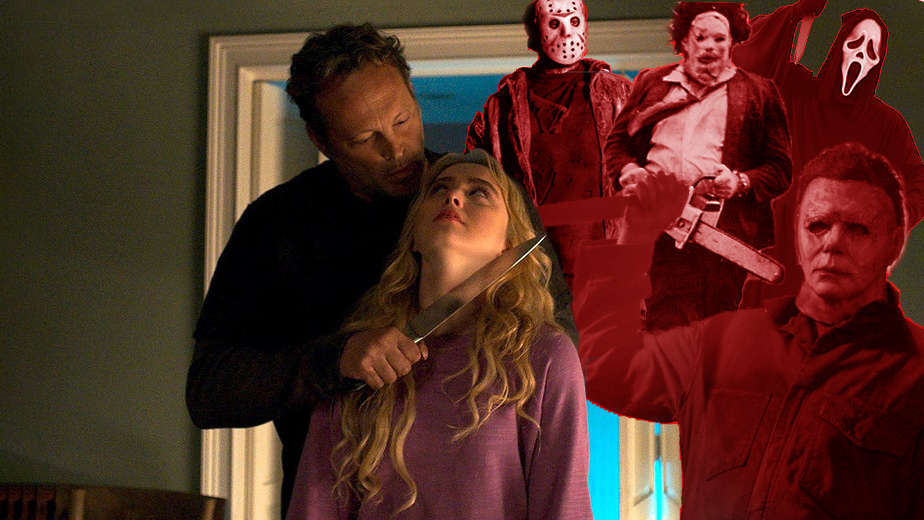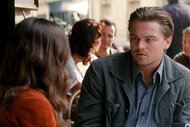Create a free profile to get unlimited access to exclusive videos, sweepstakes, and more!
Why Vince Vaughn puts other slasher villains to shame in Freaky

In many respects, the new body-swapping horror-comedy Freaky is an attentive student of slasher movies, especially of the 1980s heyday the genre shared with body-swapping comedies.
For their high-concept story of a teenage girl (Kathryn Newton) switching bodies with a hulking, relentless serial killer (Vince Vaughn), filmmakers Christopher Landon and Michael Kennedy make Vaughn’s Blissfield Butcher a composite figure of slashers past. They give him a Leatherface-style hideout, amusingly decked out with all of the creepy-weirdo-murderer trimmings (bones, animal skins, raggedy curtains); later, he picks up a number of weapons used in famous horror-movie kills; early on, he even does a signature Michael Myers head-tilt from the original Halloween. But there’s one aspect of the Blissfield Butcher that sets him apart from most fictional killers of his ilk: He’s played by an immediately recognizable actor.
As popular as slasher films became following that first Halloween movie in 1978, those then-newfangled movie monsters never really produced their own Boris Karloff or Bela Lugosi. Michael Myers, Jason Voorhees, and Leatherface are all hidden behind masks, and often switch out actors unceremoniously; that’s even part of the plotting for the Scream series, in which “Ghostface” is literally just a costume for a variety of murder-mystery solutions. This is a genre where the various stuntmen who have played Michael Myers don’t bother to create much continuity between sequels, and Kane Hodder’s late-period, four-movie run as Jason counts as longevity. Even Freddy Krueger, the Nightmare on Elm Street slasher played repeatedly, definitively, and perfectly by Robert Englund, has a de facto mask of rubbery, wrinkly makeup; Freddy’s face is ultimately a lot more famous than Englund’s.
Vaughn, on the other hand, is known for big mid-2000s hits like Wedding Crashers, Dodgeball, and Old School. Freaky is his most mainstream lead role in a while, but his nearly 25-year career all but guarantees some audience familiarity. This creates a new context for Blissfield Butcher’s quiet, unstoppable menace; Vaughn’s most famous roles depend on some combination of motor-mouthed riffing and deadpan sarcasm, and the Butcher, like his predecessors, isn’t especially chatty. (He even begins the movie as a traditional masked figure.) The reveal of Vaughn’s face eliminates the element of the unknown that infuses many of the best slashers, but paradoxically replaces it with something less familiar than those visual tropes. Horror audiences have become so accustomed to seeing anonymous masked men stalking teenagers that there’s something unexpectedly unnerving about watching Vaughn silence his distinctive delivery to fit that mold.
As it happens, Vaughn has played a slasher of sorts once before: In 1998, he took on the role of Norman Bates in Gus Van Sant’s experimental redo of Alfred Hitchcock’s proto-slasher Psycho. He was presumably cast at least in part because of his towering and then-lanky frame, and how it resembles an overgrowth of the beanpole physique Anthony Perkins brought to the original film. There, his ingratiating chatterbox routine was integrated into Norman’s seemingly mild-mannered geekiness; in Freaky, his bulkier frame serves as an immediate visual primer on how the typical slasher profile has changed since Bates. Perkins and Vaughn were both playing a dimensional person; seeing Vaughn play a more modern horror villain calls attention to the minimalism we’ve come to expect from these types of characters.
Of course, Vaughn isn’t the only actor in Freaky who gets to play the Butcher. Once the big swap happens, Kathryn Newton embodies the role for much of the remaining running time. If casting Vaughn as a Michael Myers type calls attention to the performance shifts necessary for a familiar actor to play this kind of part, Newton flips those expectations again, this time into a neat, dark joke: The nerdy outcast she’s played in the first section of the movie (as with so many teen movies, fudged to ignore the actor’s charisma and conventional attractiveness) starts looking, to her peers, cooler and more mysterious. Even audience members well aware that Newton’s character hasn’t simply donned a stylish new jacket (as it appears to her schoolmates in the film) may catch themselves marveling at her badass mystique. Suddenly, a faceless killer seems perversely chic and confident — because Newton is operating with the heedless momentum of a sociopathic male who doesn’t ever second-guess his actions.
Vaughn, meanwhile, plays Millie, the teenage girl unaccustomed to inhabiting a male body. Rather than just adopting a younger inflection in his voice, he moves differently, like someone who can’t quite get the hang of their newly towering height. It reveals just how much of the Butcher’s whole vibe comes from his lumbering gait. When that slasher physicality transfers over to Newton, her turn as the Butcher strips away the pretense of naturalism. Within the world of the movie, of course, it’s still naturalistic; she’s behaving just as the male version of the Butcher would, and she and Vaughn are both mightily convincing. But even if the character is free of affectation, the movie makes clear that this trope has its own set of performance standards.
Freaky doesn’t always explore the performative aspects of gender and genre as deeply as it could. At one point, Vaughn plays Millie “wearing” Butcher’s body and further disguised with an Aaron Rodgers mask, and mostly it’s a fun riff on the old William Shatner mask favored by Michael Myers, rather than a Charlie Kaufman-esque commentary on layers of artificiality. Landon and Kennedy want this to be a fun semi-spoof and celebration of slasher conventions, not a full-on deconstruction, and they succeed. Yet they may have contributed to a deconstruction anyway, even without Scream-style verbal callouts. It may even help that Freaky is more fun than truly scary; watching Vaughn and Newton switch mannerisms makes some classic horror standbys look more like a pantomimed ritual than gut-level terror. Next time a slasher movie pops up, it may be trickier to avoid wondering who, exactly, is lumbering around beneath that mask.



























